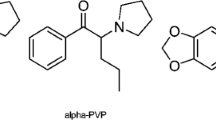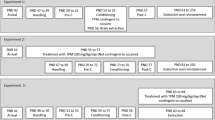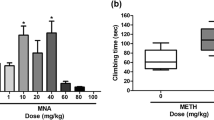Abstract
Low doses of the dopamine D3-preferring agonist 7-hydroxy-N,N-di-n-propyl-2-aminotetralin (7-OH-DPAT) produce a behavioral profile that is opposite to that produced by the psychomotor stimulants cocaine and amphetamine. For example, low doses of 7-OH-DPAT produce conditioned place aversion and hypolocomotion, whereas psychomotor stimulants produce conditioned place preference (CPP) and hyperlocomotion. In experiment 1, the effects of low doses of 7-OH-DPAT (0.01–0.1 mg/kg) on d-amphetamine-induced (1 mg/kg) motor behaviors and CPP were assessed. In experiment 2, the effects of 0.1 mg/kg 7-OH-DPAT on d-amphetamine (0–10 mg/kg) dose-response curves for the same behaviors were examined. During conditioning, drug injections were paired with a distinct compartment, whereas saline injections were paired with another compartment. Locomotion and headbobbing were measured following acute and repeated drug administration during conditioning and place conditioning was assessed 24 h following the last conditioning day. In experiment 1, d-amphetamine-induced locomotion was dose-dependently decreased by 7-OH-DPAT following repeated administration, which was probably due to the emergence of headbobbing, a behavior not observed with d-amphetamine alone. d-Amphetamine-CPP was not altered by co-administration of 0–0.03 mg/kg 7-OH-DPAT, but was attenuated by co-administration of 0.1 mg/kg 7-OH-DPAT. In experiment 2, 7-OH-DPAT co-administered with low doses of d-amphetamine (0–0.5 mg/kg) produced a decrease in locomotion following acute administration. However, 7-OH-DPAT produced sensitization of locomotion at the 0.5 mg/kg dose of d-amphetamine and an increase in headbobbing at the 0.5–10 mg/kg doses of d-amphetamine following repeated administration. In contrast, d-amphetamine-CPP was attenuated by co-administration of 7-OH-DPAT. These findings suggest that 0.1 mg/kg 7-OH-DPAT attenuates the reinforcing effects of d-amphetamine despite enhancing stereotypic behaviors.
Similar content being viewed by others
Author information
Authors and Affiliations
Additional information
Received: 14 May 1997 / Final version: 22 January 1998
Rights and permissions
About this article
Cite this article
Khroyan, T., Baker, D., Fuchs, R. et al. Differential effects of 7-OH-DPAT on amphetamine-induced stereotypy and conditioned place preference. Psychopharmacology 139, 332–341 (1998). https://doi.org/10.1007/s002130050724
Issue Date:
DOI: https://doi.org/10.1007/s002130050724




